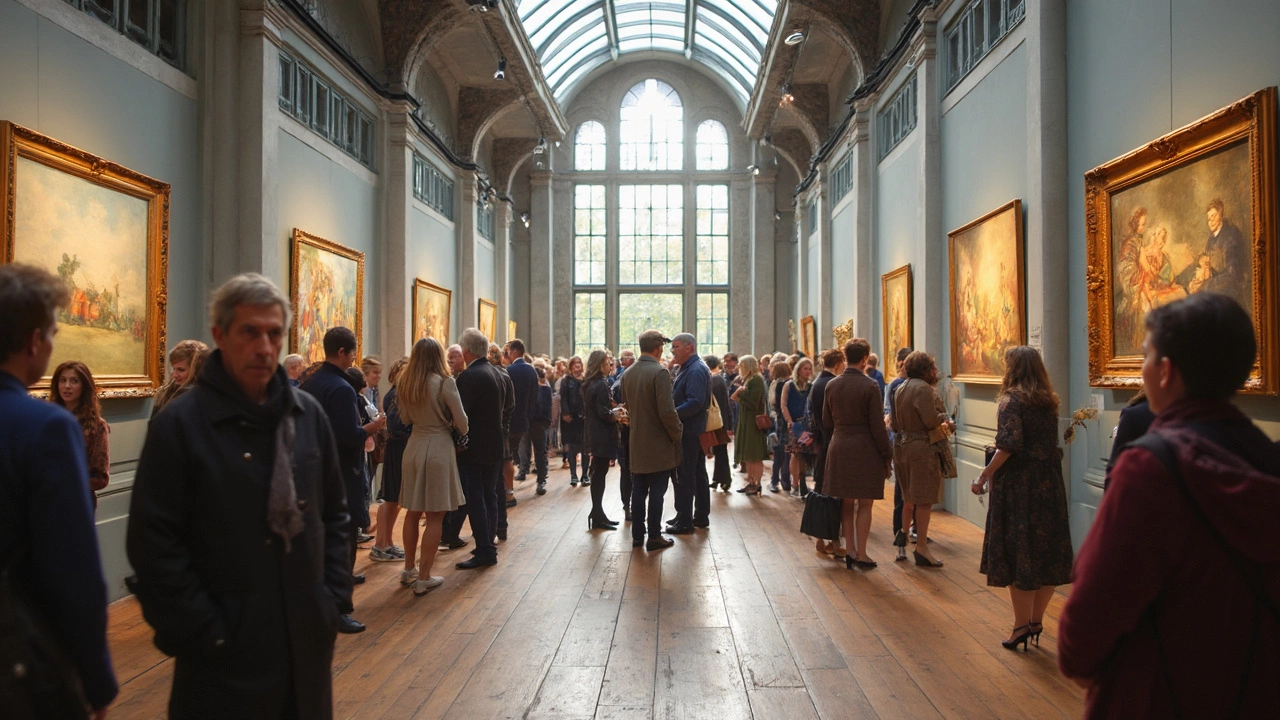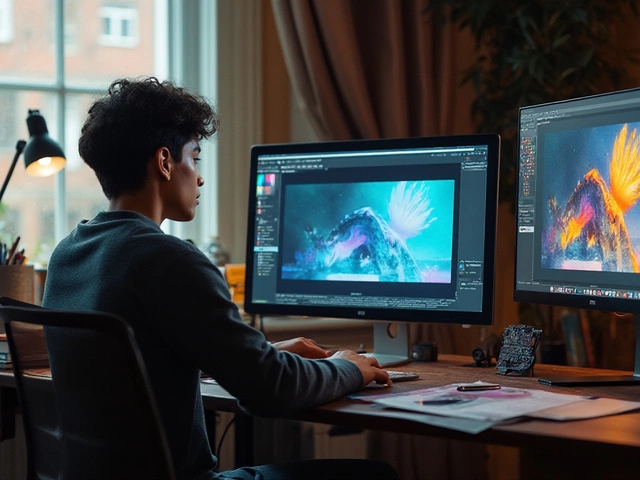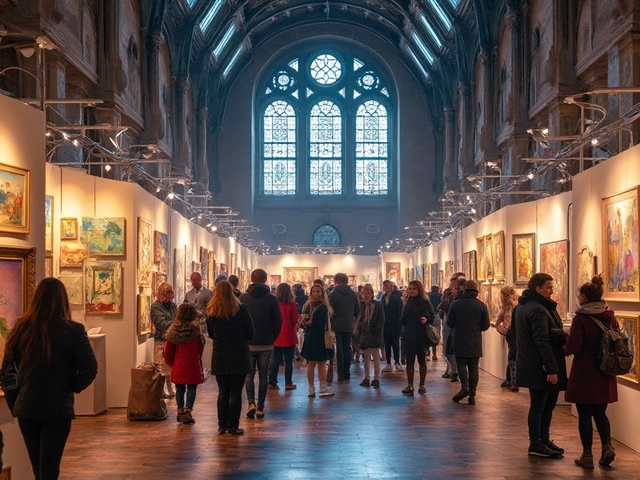If you've been stuffing canvases under your bed and hoping one day they'll make you rich, it's time for a reality check—and a plan. Selling art is a business, not just a passion project. Exhibitions aren’t old news; they’re still the fastest way for most artists to get in front of serious buyers ready to pay real cash.
But just showing up with a few paintings won’t cut it. The profits aren't in luck—they're in strategy. You need to know which exhibitions attract the right crowd, how to prep your work (and yourself!) to get attention, and how to turn those quick compliments into actual sales. Want the gallery to take you seriously? Care about walking away with more than a few likes on Instagram? Then let’s talk about what really works for turning your art into profit, right in the heart of the art world.
- Why Art Exhibitions Still Matter
- Picking the Right Exhibition for Profit
- Prepping Your Art and Pitch
- Networking That Actually Works
- Pricing Tricks That Sell
- What Comes After the Sale
Why Art Exhibitions Still Matter
Despite all the noise online, art exhibitions are still where the real money changes hands for artists. They’re the main spot where buyers can see, touch, and, yeah, even smell the art before pulling out their wallets. In 2023, over 40% of fine art sales worldwide happened in-person at gallery exhibitions—not on the web. That’s a good chunk of the $65 billion global art market right there.
Here’s why exhibitions haven’t lost their edge:
- Physical Impact: Seeing art up close beats scrolling any day. Serious collectors want to check out brushstrokes, colors, and textures in person before spending thousands.
- Instant Relationships: Exhibitions let you chat face-to-face with buyers and galleries. That personal connection often turns a “maybe” into an easy sale.
- Marketing Magnet: A good show creates buzz on social media, draws press, and gets your name into the rooms where decisions get made, way faster than waiting for an algorithm to notice you.
- Trust Factor: Galleries vouch for your work by giving you a spot. That little bit of trust from the gallery goes a long way with buyers who want to make sure they’re not getting scammed.
Check out these numbers on where art sales actually happen:
| Sales Channel | % of Total Art Sales (2023) |
|---|---|
| In-Person Exhibitions | 42% |
| Direct Online Sales | 29% |
| Auctions (Live/Online) | 21% |
| Other (Open Studios, Fairs) | 8% |
Skipping exhibitions because you think everything’s online now? You’re leaving cash—and a ton of real-world connections—on the table.
Picking the Right Exhibition for Profit
All exhibitions are not created equal when it comes to making money. Some are full of people who are just there for free wine and snacks, while others actually attract folks who’ve got money to spend. You need to focus on places and events that suit your art—and your wallet.
Here’s the thing: national and international shows usually pull bigger crowds, but the booth fees can hit your bank account hard. Local shows or smaller gallery pop-ups, on the other hand, might cost less, but you could end up with fewer buyers. It’s not just about the size—you’ve got to look at the crowd, and the reputation of the event.
If you create contemporary art, check out art fairs like Art Basel Miami Beach or The Armory Show in New York. These aren’t just any events—they’re known for high sales. But honestly, these places can be hard to break into if you’re new. Regional exhibitions, city-wide art walks, and even college showcases can offer a sweet spot: decent foot traffic, lower entry costs, and real buyers hunting for affordable pieces.
Here’s a quick side-by-side:
| Exhibition Type | Average Booth Fee | Typical Buyer Profile | Average Artwork Price |
|---|---|---|---|
| Big Art Fairs (e.g. Art Basel) | $5,000+ | Collectors, Investors | $10,000+ |
| Regional Shows | $500–$1,500 | Enthusiasts, Local Collectors | $500–$2,000 |
| Pop-up/Local Galleries | $100–$500 | Casual Buyers, New Collectors | $100–$1,000 |
Don’t ignore themed exhibitions either. A ceramics-only show or portraits event can draw buyers looking for exactly what you’re making. Sometimes, niche is more profitable than trying to appeal to everyone.
Before you pay a fee, look up the show’s visitor numbers, past sales records, and artist testimonials. Don’t take an organizer’s word for it—get recommendations from artists you trust. And check the split on sales commissions: some places take 50% or more, which eats straight into your profits. That fine print? Yeah, read it closely.
If you’re after profitable art exhibitions, do the research. The right fit is out there, but it’s up to you to spot it—and not just jump at the flashiest one.
Prepping Your Art and Pitch
There’s an art to getting your art ready for an art exhibition. It's not just about what you hang, but how you prep every detail right down to your price tags. Before you even step foot in the gallery, you want your work looking sharp and your story on point.
First, presentation makes or breaks that first impression. Seriously: a wonky canvas, dusty frame, or dingy glass will turn buyers off fast. Clean your work like you’re setting it out for royalty. If you’re using frames, pick ones that are simple and let your art stand out. Dirty, chipped, or mismatched frames send all the wrong signals.
Consistent labeling is key. Make slick, professional labels for every piece: title, size, medium, price, and your name. Not only does this boost credibility, it helps folks talk about, remember, and buy your work. According to The Art Business Journal, art that’s properly labeled and accompanied by a short story sells up to 30% faster than pieces with just the art alone.
"The artwork is half the sale; the story and context are the other half. Buyers want to feel a connection." – Amanda Adams, Art Business Consultant
Don't wing your artist pitch. The best artists practice a tight, honest summary of their style, influences, and what makes their work different. Skip long rambles or vague concepts. Buyers want something memorable, not a TED Talk.
- Pick your best, most cohesive works. Hanging everything you’ve ever made looks desperate, not confident.
- Test your pitch out loud before the show. If it takes longer than 30 seconds to explain a piece, trim it down.
- Prep a one-page sheet with high-quality photos and short bios for interested buyers to take home.
- Keep prices visible but not overwhelming—one study found buyers are 25% more likely to start a conversation if a price is displayed.
Here’s a quick comparison of what grabs buyers versus what pushes them away:
| Do This | Avoid This |
|---|---|
| Clean, matched frames | Dusty, inconsistent presentation |
| Short, clear artist pitch | Rambling explanations |
| Professional labels with story | No stories, missing prices |
| Best, connected pieces only | Random, unrelated art |
This whole prep stage isn’t glamourous, but it’s what separates artists who sell from those who hope. A little extra effort here means a bigger payoff when buyers step up to your wall.

Networking That Actually Works
You’ve probably heard that it’s not what you know, but who you know—corny, but in the art world, it’s true. At art exhibitions, the right connections can turn a quick chat into a serious sale or even a life-changing commission. But this isn’t about trading business cards and hoping someone calls. It’s about being intentional and approachable, not pushy.
Here’s how to make networking at exhibitions actually pay off:
- Pay attention to collectors who show up early—studies show the first-night crowd tends to buy most of the work that sells. Don’t hide in the corner—position yourself near your art and be ready to talk to anyone lingering nearby.
- Prepare a simple, genuine introduction. No need for a rehearsed pitch, just a quick line about your work that invites questions. For instance: "I focus on cityscapes that actually feature places I’ve biked around myself." Let people know there's a real person behind the canvas.
- Listen more than you talk. Ask collectors what they enjoy, or which pieces caught their eye tonight. People are more likely to remember—and buy from—artists who make them feel heard.
- Swap social handles, not just business cards. In a 2023 survey by Art Basel, over 60% of buyers said they followed artists on Instagram before making a purchase. Make it easy for people to keep up with you.
- Follow up. Within two days, send a short message to anyone interested in your work. Just a friendly thank you can be the difference between a missed opportunity and a sale.
Need some reasons to invest your time in this? Check out how well networking works for *art sales* at exhibitions, according to the 2024 US Art Market Insights report:
| Networking Activity | Chance of Sale Increase |
|---|---|
| Engaging with visitors directly | +45% |
| Following up within 48 hours | +62% |
| Sharing socials on the spot | +37% |
Good networking isn’t about being the pushiest person in the room. It’s about building honest relationships and making it easy for interested folks to remember you. That’s how you’ll stand out at any art exhibition.
Pricing Tricks That Sell
Here’s where a lot of artists go wrong—they either slap on a price that feels good or wildly undersell themselves out of fear. The right price can be the difference between a goodbye and a sale. Buyers at art exhibitions expect pricing to make sense. Too low and they’ll think your work isn’t worth much. Too high and they walk right by.
The sweet spot? Base it on size, medium, and experience, but always compare similar pieces locally. When I started, I checked out what artists with a similar résumé charged—turns out, pricing $200 below them made collectors suspicious. Now I stick to a formula and rarely hear anyone blink at my numbers.
Try this approach for consistent, credible pricing:
- Decide on a price per square inch or centimeter. For example, $2 per square inch is common for mid-level painters, but adjust for your market.
- Add costs: materials, framing, shipping (if included).
- Factor in your track record. Newer artists should stick close to the average, but established work can command more.
- Don’t forget venue commission—the average U.S. gallery commission is 40-50%. Mark up your price so you get what you want after their cut.
Here’s a quick look at average painting sizes and what they tend to fetch in mid-tier U.S. exhibitions (2024 data):
| Artwork Size (inches) | Average Price | Popular Price Range |
|---|---|---|
| 8x10 | $150 | $100-$300 |
| 16x20 | $450 | $300-$700 |
| 24x36 | $1,100 | $800-$2,000 |
Offer payment plans or split payments on higher-ticket items. Some buyers love a deal and may go for two smaller pieces if your pricing encourages it. And don’t be afraid of discounts—just use them right. A 10% ‘VIP preview’ discount at the opening night actually bumped my sales by 30% last year.
The point is, confident, clear, and fair pricing tells buyers that you know your value. And people are more likely to invest when they sense they’re getting a real piece of the action, not just a random number with a price tag.
What Comes After the Sale
So you’ve made a sale at the exhibition—now what? Honestly, this is where many artists drop the ball. The real gold is in what happens next, and the artists who get this step right almost always earn more down the road.
First thing’s first: delivery and follow-up matter way more than you’d think. If you just hand over a painting and vanish, you’re missing out on future connections and even bigger sales. When someone buys your work, get their details and send a short thank-you. This small step can set you apart from most other artists who barely follow up at all.
- Document the transaction. Keep a record with details like buyer contact info, sale price, and the piece sold. This isn’t just good bookkeeping—it can help if you want to show an established track record to future galleries.
- Offer proper paperwork. A certificate of authenticity or receipt makes you look professional. Serious collectors expect these and it makes your sell art game much stronger.
- Stay in touch. Send updates about your next exhibition or new pieces. Studies show that returning buyers spend almost 67% more than first-timers, so keeping these folks in your circle is smart (source: Artsy, 2023).
Handling logistics is part of the game. If your work needs shipping, package it well and insure it—no one wants a cracked canvas showing up at their door. If the buyer paid through a gallery, check when and how you’ll get paid. Each gallery has their own process, but most pay within 30 days of the show ending.
| Post-Sale To-Do | Why It Matters |
|---|---|
| Send Thank-You Note | Builds loyalty and trust with buyers |
| Log Sale Details | Aids in tax prep, future marketing |
| Provide Documentation | Adds value for serious collectors |
| Network for Next Sale | Repeats business and referrals |
Here’s something I learned the hard way: communities of collectors love talking. Treat one buyer well and you might end up recommended to their friends or even picked up by another gallery. My spouse Merriweather still laughs about the time a single exhibition sale led to a full series commission from a buyer’s cousin. It snowballs, if you don’t disappear after the show.
The bottom line? Locking in a sale is just step one—the follow-up is how you build lasting success (and stay at the top of the list when galleries look for artists that bring in buyers).





